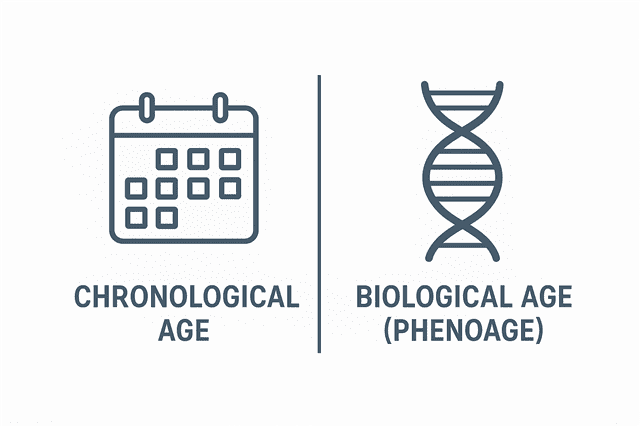Degeneration and PhenoAge: The Connection between Your Spine and Aging (and How to Slow It)
Most people think degeneration simply “comes with age.” But modern longevity research shows a different story:I have spent my entire career helping people who have been told that they would “just have to live with it” because of their age. I’ve also spent my entire career adjusting people and, after a good adjustment, telling them “that’s the sound of you getting younger”. I’m excited to see that researchers have compiled data and evidences to depict phenotypic aging. The value is that we don’t define aging in years but as the accumulation of processes – processes that we can control. We can take control through movement, healing and nutrition.
Your body has two ages — your chronological age and your biological age.

PhenoAge (Phenotypic Age) is a scientific estimate of how fast you and your tissues are aging based on biomarkers related to inflammation, cellular turnover, metabolic stress, and immune function. In many patients, degeneration of the spine and joints is one of the earliest and most visible indicators that their biological age is running ahead of schedule. I would go further and say that aging of the spine is not simply a reflection of these processes but a contributor.
Understanding this connection helps patients take control of aging as a process instead of letting symptoms dictate and control your life.
What Exactly Is PhenoAge? (Technical Breakdown)
PhenoAge was developed from large-scale longevity studies that identified biomarkers strongly tied to early mortality, inflammation, and tissue breakdown. I expect another major contributor, one which we are just beginning to quantify, is glycation.
These include:
• CRP (C-reactive protein) — inflammation marker
• White blood cell counts — immune system stress
• Glucose levels — metabolic aging
• Albumin — tissue repair capacity
• Lymphocyte percentage — immune resilience
• Creatinine — muscle and kidney function
• Red cell distribution width (RDW) — cellular turnover
• Alkaline phosphatase — tissue remodeling
• Chronological age — baseline input
Researchers discovered that these markers reveal how old your body behaves, even if your birthday says otherwise.
A higher PhenoAge means:
• More inflammation• Slower healing
• Decreased cellular energy (lower mitochondrial function)
• Higher oxidative stress
• Faster tissue degeneration-This includes spinal discs, joints, cartilage, and ligaments — all of which are extremely sensitive to inflammation and mechanical stress.
How PhenoAge Connects to Degeneration
Degeneration is not simply “wear and tear.” It’s a biological process driven by inflammation, micro-damage, impaired repair mechanisms, and mechanical stress over time.
When PhenoAge increases, several things happen at the tissue level:
1. Collagen breakdown accelerates-Inflammatory cytokines (IL-6, TNF-α) weaken connective tissue and reduce disc hydration.
2. Cartilage loses its ability to repair-Cells called chondrocytes enter “senescence,” meaning they stop repairing tissue but continue secreting inflammatory chemicals — speeding degeneration.
3. Microcirculation decreases-Reduced blood flow limits oxygen and nutrient delivery to discs and facet joints.
4. More oxidative stress = faster joint aging-Free radical accumulation damages proteins and accelerates thinning of discs.
5. Mechanical load becomes more harmful-When tissues are already inflamed or aging biologically, normal daily postures — sitting, bending, lifting — create disproportionate damage.
This is why two people the same age can show completely different levels of disc degeneration on imaging. Further, it should be noted that many of the items on this list are reversible and otherwise manageable. Much of this can be summed up in what we call “Staying Adjusted”
Why the Spine Shows Biological Aging First
Your spine is highly sensitive to changes in
:• Inflammation
• Mechanical alignment
• Circulation
• Neuromuscular control
• Repetitive stress• Cellular repair capacity
Because spinal discs have no direct blood supply, they depend on movement and proper mechanics to receive nutrients. You can learn more about how this ties into joint inflammation in our Arthritis article.
When mobility is limited — even slightly — degeneration accelerates.
This explains why
• Desk workers show early disc thinning
• Prior injuries increase future degeneration
• Poor posture contributes to arthritis
• Sedentary lifestyles elevate biological age
These are mechanical stressors, but they create inflammatory reactions that raise PhenoAge and deepen degeneration.
Chiropractic Care and PhenoAge: The Overlooked Connection

While chiropractic care is known for improving joint mobility and reducing pain, its impact on biological aging is often misunderstood. There is movement and then there is Chiropractic-Level movement. The master of joint-by-joint movement in the spine is the Chiropractor.
Research on mobility, inflammation, and neuro-musculoskeletal function shows several mechanisms by which chiropractic strategies can support lower PhenoAge:
1. Reduced systemic inflammation-Improved joint function decreases release of inflammatory mediators from overloaded or stuck joints.
2. Better autonomic regulation-Adjustments influence the nervous system’s stress response, which affects cortisol levels, immune activity, and inflammation — all core parts of PhenoAge.
3. Enhanced nutrient flow to discs-Movement-based therapies and adjustments promote fluid exchange in cartilage and discs, slowing degenerative changes.
4. Improved mitochondrial function through movement-Regular movement enhances cellular energy production, which slows biological aging at the tissue level.
5. Correction of micro-instability-Misalignments alter load distribution, accelerating disc breakdown. Correcting these protects structural longevity.
6. Slowing cellular senescence-Reducing mechanical stress and inflammation decreases the “aging signals” that push cells toward degeneration.
Who Is More Likely to Have a High PhenoAge (and Faster Degeneration)?
Scientific studies link higher biological age to:
• Chronic stress
• Poor sleep
• Elevated inflammation markers
• High blood sugar or insulin resistance
• Sedentary lifestyle
• Smoking• Obesity• Repetitive physical strain
• Old injuries
• Poor spinal alignment• Immune dysregulation
Many patients unknowingly have a higher PhenoAge — and their spine often reveals it before blood tests do. Most patients are suprised when we X-ray and say “your spine is 40 but looks 70!” Or “your spine is 40 but looks 25!”. That’s phenoage in action.
How Chiropractors Detect Accelerated Aging in the Spine
During an evaluation, chiropractors look for: (care for aging could become it’s own service with things like imaging, nutritional/lifestyle consultation?)
• Loss of segmental motion
• Altered curvature or posture (cervical straightening, kyphosis, anterior pelvis tilt)
• Early disc height reduction
• Bone spur formation
• Facet joint stress patterns
• Muscle imbalance
• Neurological irritation
• Compensatory movement patterns
These patterns correlate strongly with accelerated biological aging and long-term degenerative changes.
Can Degeneration Be Improved or Slowed?
Structurally, degeneration cannot be completely reversed once present, but functionally and biologically, a great deal can be improved:
Improvements seen with care:
• Better mobility
• Reduced inflammatory load
• Slowed joint breakdown
• Improved posture and load distribution
• Increased hydration of discs
• Reduced nerve irritation
• Better energy and recovery
• Lower biological aging markers (PhenoAge inputs)
Biological aging is highly modifiable, and chiropractic plays an important role by targeting the mechanical and inflammatory drivers behind elevated PhenoAge.
Takeaway: Your Spine Tells the Truth About How Fast You’re Aging
Degeneration is not purely age-related. It is deeply connected to biological aging, inflammation, stress, and lifestyle. PhenoAge gives us powerful insight into why your body is aging — and your spine often shows it early. With the right chiropractic strategies focused on movement, alignment, and reducing inflammatory load, you can slow biological aging, protect your spine, and improve longevity.
The benefits of chiropractic management on movement, nutrition and lifestyle can be yours- go find yourself a good chiropractor!
Levine, Morgan E., et al. “An Epigenetic Biomarker of Aging for Lifespan and Healthspan.” Aging (Albany NY), vol. 10, no. 4, 2018, pp. 573–591. PubMed Central, doi:10.18632/aging.101414.
Kim, Chobok S., Soowon Park, and Jin-Hwan Kim. “The Role of Glycation in the Pathogenesis of Aging and Its Prevention through Herbal Products and Physical Exercise.” Journal of Exercise Nutrition & Biochemistry, vol. 21, no. 3, 2017, pp. 55–61. PubMed Central, doi:10.20463/jenb.2017.0027.
Written by: Donaid Seals D.C
Dr. Seals is a practicing Doctor of Chiropractic with over 25 years of experience caring for people. His thinking is the product of his education, practice experience and many years in the natural foods and fitness industry. He has become living proof that old muscleheads don’t die-or fade away; sometimes they grow up to bring real-world expertise to the clinical picture. Traditional background information is available here.


